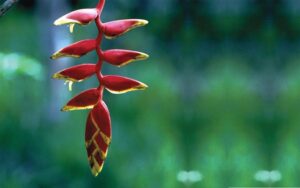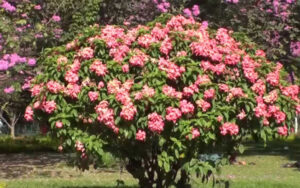Clianthus: Beauty thriving in gardens worldwide
New Delhi: Clianthus is an evergreen shrub with beautiful flowers and belongs to the pea family, Fabaceae. It is native to New Zealand, where it is called kakabeak by the Maori people. The flower gets its name because it looks like the beak of a native parrot called the kaka. Clianthus produces hanging clusters of bright red flowers up to 7 cm long. While red flowers are the most common, there are also pink and white varieties. It is also known as glory pea, parrot’s beak, parrot’s bill, and lobster claw because of its unique flower shape.
There are two types of Clianthus: Clianthus puniceus and Clianthus maximus. Clianthus puniceus is now only found in the wild on Moturemu Island in New Zealand’s Kaipara Harbour. In 2005, a survey showed that only 153 Clianthus maximus plants remained in the world, mostly in the East Cape area. Luckily, Clianthus is grown in many countries around the world and is a popular garden plant in New Zealand. In colder places, it is often grown in greenhouses or conservatories.
New Zealand, replete with lush landscapes and unique biodiversity, is home to some of the most fascinating plants in the world. Among these botanical treasures, the Clianthus genus stands out for its striking beauty and cultural significance. Commonly known as kakabeak, this plant is not just a feast for the eyes but also a symbol of resilience and heritage. Its vibrant red, beak-shaped flowers resemble the curved beak of the native kaka parrot, lending it other nicknames like “parrot’s beak,” “parrot’s bill,” and “lobster Rose.” Let’s explore why this rare and beautiful plant deserves its place in the spotlight.
Beauty of Kakabeak
Clianthus consists of two species, Clianthus puniceus and Clianthus maximus, both endemic to New Zealand’s North Island. They are celebrated for their clusters of vivid red flowers that bloom from spring to early summer, though sometimes flowers bloom twice a year or even year-round. These shrubs typically grow up to two meters tall and have spreading branches adorned with delicate, pinnate leaves.
While red flowers are the most common, there are also varieties with creamy white or pink flowers, such as the aptly named “Albus” and “Roseus.” These plants are not only visually captivating but also attract pollinators like birds, particularly hummingbirds, with their nectar-rich blooms.
A lovely, but rather tender shrub for the larger, milder garden, Clianthus puniceus Roseus is an evergreen, climbing shrub, which will need the support of a trellis or wires and needs to be tied in. The deep green leaves are pinnate (heavily divided). Hanging, deep pink, rather claw-like flowers appear in May and June, each 3 ½”/7 “cm long. This plant benefits from being planted against a warm wall in full sun. Apply a generous, deep, dry mulch over winter. After flowering, remove any dead or damaged wood, and cut back stems by a third to promote next year’s flowers. Lobster Claw Roseus holds the RHS Award of Garden Merit.
Also Read: Nong Nooch Garden: A perfect blend of nature, culture, and innovation
Plant of Historical Importance
Kakabeak has a rich history intertwined with the culture of New Zealand’s indigenous Maori people. The Ngai Tai ki Tamaki tribe traditionally cultivated Clianthus plants, using them for nitrogen fixation in kamara (sweet potato) plantations on Motukaraka Island. The vibrant flowers were also woven into garlands for high-ranking women, emphasizing their significance in Maori society.
European settlers quickly recognized the plant’s beauty and began cultivating it. Joseph Banks and Daniel Solander first collected specimens in 1769, but it wasn’t formally described until 1835. Over the years, Clianthus has captured the attention of botanists and gardeners worldwide, with seeds and plants spreading to places like California and England. When the plant becomes too big for its pot. The roots do not appreciate being disturbed, so place your Clianthus in a larger pot without disturbing the roots.
Despite its beauty and historical importance, Clianthus is in trouble. Both species are endangered, with C. puniceus classified as critically endangered. Wild populations are scarce and face numerous threats, including habitat loss, invasive species, and herbivory by introduced animals.
The situation is particularly dire for C. puniceus, which now exists naturally only on Moturemu Island in Kaipara Harbour. In a 2005 survey, fewer than 200 individual plants of C. maximus were found in the wild, primarily in the East Cape region. This number marked a steep decline from the 1,000 plants recorded in 1996. The limited genetic diversity among cultivated plants exacerbates the problem, making them vulnerable to diseases and environmental changes.
Unique Adaptations for Survival
Kakabeak plants have evolved remarkable adaptations to survive in their native environment. Their seeds, which are kidney-shaped and covered in a hard coat, can remain viable in the soil for years, allowing the plant to endure periods of adversity. These seeds are primarily dispersed by gravity, water, and wind, with pods designed to float and travel.
The flowers themselves are a marvel of nature, specifically adapted for bird pollination. While they lack a strong fragrance, they compensate with abundant nectar to attract avian visitors. Interestingly, the flowers have a protective cuticle over their stigma, which prevents self-pollination and encourages genetic diversity through cross-pollination.
Challenges to Survival
Despite these adaptations, Clianthus faces numerous challenges. Habitat destruction, competition from invasive plants, and predation by introduced animals have decimated wild populations. Human activity has also played a significant role, with seed collection and habitat modification further threatening the species. However, not all human influence has been negative. Efforts to cultivate and propagate Clianthus in gardens and conservation areas have helped prevent its complete extinction.
Clianthus in Culture and Conservation
The significance of Clianthus extends beyond its ecological role. The plant has appeared on New Zealand postage stamps and holds a special place in the nation’s cultural identity. Its red flowers, along with those of the pahutukawa and the yellow kowhai, are iconic symbols of New Zealand’s flora.
Conservation efforts are underway to protect Clianthus and its habitat. Organizations and individuals are working to restore wild populations and safeguard the genetic diversity of cultivated plants. These efforts are crucial for ensuring the survival of this stunning plant for future generations.
Clianthus in the Garden
For gardening enthusiasts, Clianthus is a prized addition to any landscape. Its vibrant flowers and graceful form make it a showstopper. While C. maximus is more robust and commonly grown in New Zealand gardens, C. puniceus is also cultivated in regions like the United Kingdom, where it has received accolades like the Royal Horticultural Society’s Award of Garden Merit.
Planting and care
To grow Clianthus puniceus, plant it in soil where the winter temperatures do not fall below -6°C (21.2°F) for short periods. The best time to plant the sapling of Clianthus is during the spring. The plant requires ordinary, well-drained, rocky soil enriched with gravel, preferably limestone, and should be kept cool during summers. Choose a sunny spot or partial shade sheltered from the wind. It is not very demanding in terms of soil but requires watering during its growth and flowering period. Be careful of gastropod attacks, which are fond of young shoots and leaves of the Clianthus.
For pot cultivation, prepare a mixture of horticultural compost, garden soil, and gravel in equal parts. Place a layer of gravel at the bottom of the pot (with drainage holes) to ensure excess water drainage during watering. Water regularly throughout the growing season and reduce water in winter, providing the soil doesn’t dry out completely. Fertilizer is beneficial but should not be too rich, especially in nitrogen. Store your Clianthus puniceus in a very bright, unheated, or minimally heated place, protected from frost during the coldest period. Prune sparingly, if necessary, just after flowering.
Clianthus puniceus White Heron looks striking as a standalone bush, integrating into an exotic setting in a mild climate garden. Its low hardiness allows planting in the ground in zone 9, in a sheltered location. Gardeners in cooler climates can grow it in a large pot, to be stored away in winter in a cool and bright space, as it dislikes overly heated and dry atmospheres. Plants grown in pots or containers are less tolerant of water shortages than those grown in the ground.
Therefore, it’s essential to maintain regular watering throughout the growing season and reduce it during winter. Some varieties that require consistent watering include ‘Kaka King’ and ‘Flamingo,’ as well as Boronia heterophylla, which thrive in similar conditions. Other examples include Brugmansia and Jacaranda mimosifolia, both of which produce flowers during spring and autumn.
Science of Clianthus
Botanists have long been fascinated by Clianthus. The plant forms a clade with the genus Carmichaelia (New Zealand broom) and is closely related to the Australian genus Swainsona. Interestingly, Swainsona formosa, known as Sturt’s desert pea, was once classified as a Clianthus species due to its similar appearance.
Research has also delved into the plant’s flowering mechanisms. Clianthus follows the ABC model of flower development, a universal framework that explains how floral organs form. Studies have revealed that the timing of flowering varies among related genera, with Clianthus initiating flowers shortly after the previous season’s blooms.
Call to Action
The story of Clianthus is one of beauty, resilience, and vulnerability. As a critically endangered plant, it serves as a reminder of the delicate balance between nature and human activity. Conservation efforts must continue to protect this botanical treasure and the unique ecosystems it represents.
By cultivating Clianthus in gardens and supporting conservation initiatives, we can help ensure that future generations can marvel at its vibrant flowers and appreciate its cultural significance. In doing so, we honor not only the plant itself but also the rich heritage of New Zealand’s flora and the people who have cherished it for centuries.
Clianthus, with its parrot-beak-shaped flowers and storied history, is more than just a plant. It is a symbol of New Zealand’s natural beauty, a testament to the resilience of life, and a call to action for conservation. Let us celebrate this remarkable genus and work together to secure its future.
By YP Singh
Editor, Nursery Today

















